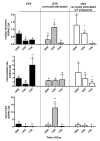Oxytocin action at the lactotroph is required for prolactin surges in cervically stimulated ovariectomized rats
- PMID: 17615142
- PMCID: PMC2085361
- DOI: 10.1210/en.2007-0646
Oxytocin action at the lactotroph is required for prolactin surges in cervically stimulated ovariectomized rats
Abstract
Cervical stimulation induces two daily rhythmic prolactin surges, nocturnal and diurnal, which persist for several days. We have shown that a bolus injection of oxytocin initiates a similar prolactin rhythm, which persists despite low levels of oxytocin after injection. This suggests that oxytocin may trigger the cervical stimulation-induced rhythmic prolactin surges. To investigate this hypothesis, we infused an oxytocin antagonist that does not cross the blood-brain barrier for 24 h before and after cervical stimulation and measured serum prolactin. We also measured dopaminergic neuronal activity because mathematical modeling predicted that this activity would be low in the presence of the oxytocin antagonist. We thus tested this hypothesis by measuring dopaminergic neuronal activity in the tuberoinfundibular, periventricular hypophyseal, and tuberohypophyseal dopaminergic neurons. Infusion of oxytocin antagonist before cervical stimulation abolished prolactin surges, and infusion of oxytocin antagonist after cervical stimulation abolished the diurnal and significantly decreased the nocturnal surges of prolactin. The rhythmic prolactin surges returned after the clearance of the oxytocin antagonist. Hypothalamic dopaminergic activity was elevated in antiphase with prolactin surges, and the antiphase elevation was abolished by the oxytocin antagonist in the tuberoinfundibular and tuberohypophyseal dopaminergic neurons, consistent with the mathematical model. These findings suggest that oxytocin is a physiologically relevant prolactin-releasing factor. However, the cervical stimulation-induced prolactin surges are maintained even in the absence of oxytocin actions at the lactotroph, which strongly suggests the maintenance of prolactin surges are not dependent upon oxytocin actions at the pituitary gland.
Figures






Similar articles
-
The rhythmic secretion of mating-induced prolactin secretion is controlled by prolactin acting centrally.Endocrinology. 2009 Jul;150(7):3245-51. doi: 10.1210/en.2009-0095. Epub 2009 Mar 12. Endocrinology. 2009. PMID: 19282380 Free PMC article.
-
Central clock regulates the cervically stimulated prolactin surges by modulation of dopamine and vasoactive intestinal polypeptide release in ovariectomized rats.Neuroendocrinology. 2010;91(2):179-88. doi: 10.1159/000254379. Epub 2009 Oct 29. Neuroendocrinology. 2010. PMID: 19887760 Free PMC article.
-
Oxytocin, vasoactive-intestinal peptide, and serotonin regulate the mating-induced surges of prolactin secretion in the rat.Endocrinology. 1990 Jan;126(1):279-84. doi: 10.1210/endo-126-1-279. Endocrinology. 1990. PMID: 2136724
-
Rhythmic secretion of prolactin in rats: action of oxytocin coordinated by vasoactive intestinal polypeptide of suprachiasmatic nucleus origin.Endocrinology. 2004 Jul;145(7):3386-94. doi: 10.1210/en.2003-1710. Epub 2004 Mar 19. Endocrinology. 2004. PMID: 15033917 Free PMC article.
-
A tale of two rhythms: the emerging roles of oxytocin in rhythmic prolactin release.J Neuroendocrinol. 2010 Jul;22(7):778-84. doi: 10.1111/j.1365-2826.2010.02012.x. Epub 2010 Apr 29. J Neuroendocrinol. 2010. PMID: 20456600 Free PMC article. Review.
Cited by
-
Vasoactive intestinal polypeptide modulates the estradiol-induced prolactin surge by entraining oxytocin neuronal activity.Brain Res. 2008 Feb 27;1196:65-73. doi: 10.1016/j.brainres.2007.12.061. Epub 2008 Jan 3. Brain Res. 2008. PMID: 18234164 Free PMC article.
-
Direct stimulatory effects of oxytocin in female rat gonadotrophs and somatotrophs in vitro: comparison with lactotrophs.Endocrinology. 2015 Feb;156(2):600-12. doi: 10.1210/en.2014-1543. Epub 2014 Nov 19. Endocrinology. 2015. PMID: 25406939 Free PMC article.
-
Systemic oxytocin induces a prolactin secretory rhythm via the pelvic nerve in ovariectomized rats.Am J Physiol Regul Integr Comp Physiol. 2011 Sep;301(3):R676-81. doi: 10.1152/ajpregu.00176.2011. Epub 2011 Jun 15. Am J Physiol Regul Integr Comp Physiol. 2011. PMID: 21677274 Free PMC article.
-
Antagonism of oxytocin prevents suckling- and estradiol-induced, but not progesterone-induced, secretion of prolactin.Endocrinology. 2009 May;150(5):2292-9. doi: 10.1210/en.2008-1611. Epub 2008 Dec 23. Endocrinology. 2009. PMID: 19106214 Free PMC article.
-
Selective oxytocin receptor activation in the ventrolateral portion of the ventromedial hypothalamus is required for mating-induced pseudopregnancy in the female rat.Endocrinology. 2008 Feb;149(2):836-42. doi: 10.1210/en.2007-1040. Epub 2007 Nov 15. Endocrinology. 2008. PMID: 18006631 Free PMC article.
References
-
- Butcher RL, Fugo NW, Collins WE. Semicircadian rhythm in plasma levels of prolactin during early gestation in the rat. Endocrinology. 1972;90:1125–1127. - PubMed
-
- Smith MS, Neill JD. Termination at midpregnancy of the two daily surges of plasma prolactin initiated by mating in the rat. Endocrinology. 1976;98:696–701. - PubMed
-
- Soares MJ, Faria TN, Roby KF, Deb S. Pregnancy and the Prolactin Family of Hormones - Coordination of Anterior-Pituitary, Uterine, and Placental Expression. Endocr Rev. 1991;12:402–423. - PubMed
-
- Freeman ME, Smith MS, Nazian SJ, Neill JD. Ovarian and hypothalamic control of the daily surges of prolactin secretion during pseudopregnancy in the rat. Endocrinology. 1974;94:875–882. - PubMed
-
- Freeman ME, Banks JA. Hypothalamic sites which control the surges of prolactin secretion induced by cervical stimulation. Endocrinology. 1980;106:668–673. - PubMed

